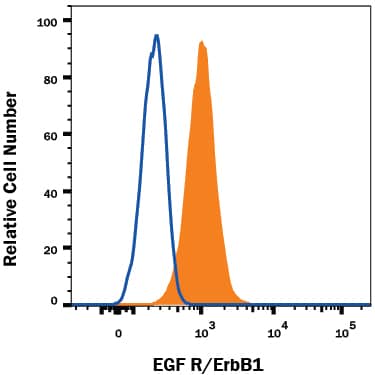Human EGFR Antibody
R&D Systems, part of Bio-Techne | Catalog # MAB10951


Key Product Details
Species Reactivity
Applications
Label
Antibody Source
Product Specifications
Immunogen
Leu25-Ser645
Accession # CAA25240
Specificity
Clonality
Host
Isotype
Scientific Data Images for Human EGFR Antibody
Detection of EGFR in A431 Human Cell Line by Flow Cytometry.
A431 human epithelial carcinoma cell line was stained with Rat Anti-Human EGFR Monoclonal Antibody (Catalog # MAB10951, filled histogram) or isotype control antibody (Catalog # MAB006, open histogram), followed by Allophycocyanin-conjugated Anti-Rat IgG Secondary Antibody (Catalog # F0113). View our protocol for Staining Membrane-associated Proteins.Applications for Human EGFR Antibody
CyTOF-ready
Flow Cytometry
Sample: A431 human epithelial carcinoma cell line
Formulation, Preparation, and Storage
Purification
Reconstitution
Formulation
Shipping
Stability & Storage
- 12 months from date of receipt, -20 to -70 °C as supplied.
- 1 month, 2 to 8 °C under sterile conditions after reconstitution.
- 6 months, -20 to -70 °C under sterile conditions after reconstitution.
Background: EGFR
Epidermal Growth Factor Receptor (EGFR), also named erythroblastic leukemia viral oncogene homolog 1 (ErbB1), is a member of the type I receptor tyrosine kinase superfamily. The epidermal growth factor receptor (EGFR) subfamily of receptor tyrosine kinases comprises four members: EGFR (also known as HER1, ErbB1or ErbB), ErbB2 (Neu, HER2), ErbB3 (HER3), and ErbB4 (HER4). All family members are type I transmembrane glycoproteins that have an extracellular domain with two ligand binding cysteine rich domains, separated by a spacer region, and a cytoplasmic domain with a membrane proximal tyrosine kinase domain and a C-terminal tail with multiple tyrosine autophosphorylation sites. The human EGFR geneencodes a 1210 amino acid (aa) residue precursor with a 24 aa putative signal peptide, a 621 aa extracellular domain, a 23 aa transmembrane domain, and a 542 aa cytoplasmic domain. EGFR has been shown to bind a subset of the EGF family ligands, including EGF, amphiregulin, TGF alpha, betacellulin, epiregulin, heparin-binding EGF and neuregulin-2 alpha, in the absence of a coreceptor. Ligand binding induces EGFR homodimerization as well as heterodimerization with ErbB2, resulting in kinase activation, tyrosine phosphorylation and cell signaling. EGFR can also be recruited to form heterodimers with ligand-activated ErbB3 or ErbB4. EGFR signaling has been shown to regulate multiple biological functions including cell proliferation, differentiation, motility and apoptosis. In addition, EGFR signaling has also been shown to play a role in carcinogenesis (1 ‑ 3).
References
- Daly, R.J. (1999) Growth Factors, 16:255.
- Schlessinger, J. (2000) Cell. 103:211.
- Maihle, N.J. et al. (2002) Cancer Treat. Res. 107:247.
Long Name
Alternate Names
Gene Symbol
UniProt
Additional EGFR Products
Product Documents for Human EGFR Antibody
Product Specific Notices for Human EGFR Antibody
For research use only